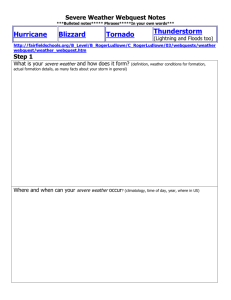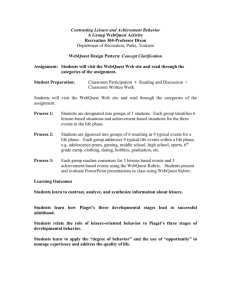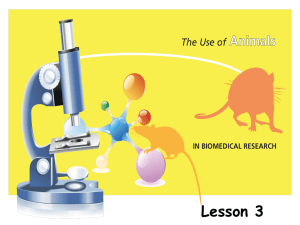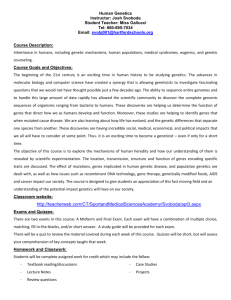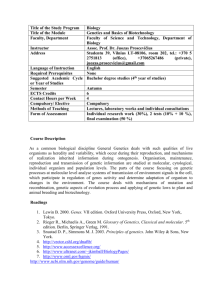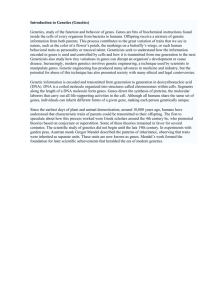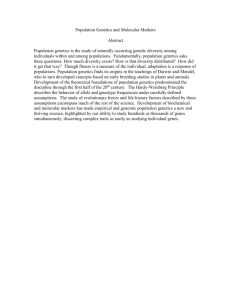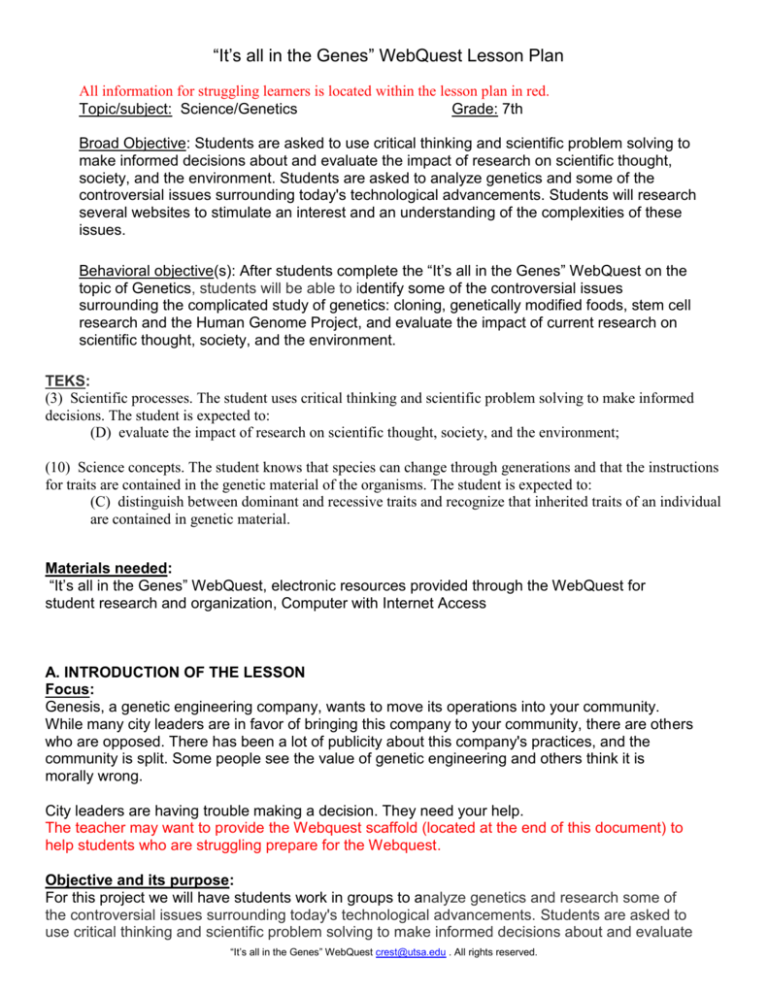
“It’s all in the Genes” WebQuest Lesson Plan
All information for struggling learners is located within the lesson plan in red.
Topic/subject: Science/Genetics
Grade: 7th
Broad Objective: Students are asked to use critical thinking and scientific problem solving to
make informed decisions about and evaluate the impact of research on scientific thought,
society, and the environment. Students are asked to analyze genetics and some of the
controversial issues surrounding today's technological advancements. Students will research
several websites to stimulate an interest and an understanding of the complexities of these
issues.
Behavioral objective(s): After students complete the “It’s all in the Genes” WebQuest on the
topic of Genetics, students will be able to identify some of the controversial issues
surrounding the complicated study of genetics: cloning, genetically modified foods, stem cell
research and the Human Genome Project, and evaluate the impact of current research on
scientific thought, society, and the environment.
TEKS:
(3) Scientific processes. The student uses critical thinking and scientific problem solving to make informed
decisions. The student is expected to:
(D) evaluate the impact of research on scientific thought, society, and the environment;
(10) Science concepts. The student knows that species can change through generations and that the instructions
for traits are contained in the genetic material of the organisms. The student is expected to:
(C) distinguish between dominant and recessive traits and recognize that inherited traits of an individual
are contained in genetic material.
Materials needed:
“It’s all in the Genes” WebQuest, electronic resources provided through the WebQuest for
student research and organization, Computer with Internet Access
A. INTRODUCTION OF THE LESSON
Focus:
Genesis, a genetic engineering company, wants to move its operations into your community.
While many city leaders are in favor of bringing this company to your community, there are others
who are opposed. There has been a lot of publicity about this company's practices, and the
community is split. Some people see the value of genetic engineering and others think it is
morally wrong.
City leaders are having trouble making a decision. They need your help.
The teacher may want to provide the Webquest scaffold (located at the end of this document) to
help students who are struggling prepare for the Webquest.
Objective and its purpose:
For this project we will have students work in groups to analyze genetics and research some of
the controversial issues surrounding today's technological advancements. Students are asked to
use critical thinking and scientific problem solving to make informed decisions about and evaluate
“It’s all in the Genes” WebQuest crest@utsa.edu . All rights reserved.
the impact of research on scientific thought, society, and the environment. Students will research
several websites to stimulate an interest and an understanding of the complexities of these
issues.
B. LESSON PROCEDURE
Input:
Genetic engineering, or genetic modification, is highly controversial. As new technologies emerge,
it is now possible to use what we know about genetics to cure diseases; create new medicines;
create healthier, tastier foods; clone animals, and help humans live longer. Many people are
troubled by the social, ethical and religious implications of using science in this way.
This topic raises important questions, and everyone has an opinion. In groups, you will examine
the topic of genetics. What is genetics and why is it important to each and every one of us? Why
is the study of genetics so controversial today?
Each member of your group will examine one of the controversial issues in genetics today from a
different perspective: Parent, Scientist, Religious Leader, and Lawmaker.
Each member has a different perspective that needs to be shared so that all opinions on this topic
can be heard. Your group will participate in a debate at the next city council meeting. The results
of this debate will decide whether Genesis gets to practice genetic modification in your community
or if the company has to find another location.
The teacher may provide examples of what is meant by a perspective (for students who are
struggling).
Modeling/guided practice:
The teacher will demonstrate how to navigate through the WebQuest and where to find the
resources the students will need to complete the WebQuest. The teacher will want to review note
taking skills.
Independent practice:
Step 1: (2 days)
Today's technological advancements make it possible for scientists to genetically modify or alter
the foods we eat, the animals we breed and potentially, the children we raise. Who doesn't want
tastier, healthier fruits and vegetables; or stronger, meatier animals; or even perfect children?
Genetics is a complicated subject. To better prepare for the community debate, each group will
review the following resources:
The teacher may want to explain genetically modify and provide examples to assist students who
are struggling.
From the American Museum of Natural History, read "What's the Big Idea?"
Go on a Genetic Journey
A Nature and Nurture Walk
The Science Scoop on the Human Genome Project
“It’s all in the Genes” WebQuest crest@utsa.edu . All rights reserved.
All About Cloning
The Quest for the Perfect Tomato
Be sure to take notes on the important ideas that make the study of genetics controversial. As you
read the resources provided, remember to consider what you read from the perspective you have
been assigned: Parent, Scientist, Religious Leader, and Lawmaker.
(For students who are struggling): The teacher may want to provide concrete examples of the
issues that might be of concern for each of the perspectives. For example, if a struggling learner
is examining information from the perspective of a parent, the teacher might want to discuss what
kinds of issues concern parents, like how genetics affect their children, how might it affect the
food they buy, etc.
When you have reviewed the resources above, complete this study guide.
The teacher may want to consider providing the study guide for struggling learners as they review
the websites.
Step 2: (2 day)
To have a thorough understanding of this topic, each group member should be able to answer
these questions.
What is DNA?
What is a Gene?
What is a Chromosome?
What is a Protein?
What is Heredity?
What is a Trait?
When you have reviewed the resources, use these flash cards to record the definitions of the
words above. Grab a partner and see how many of these words you can explain without looking.
The teacher may want to provide the flash cards for struggling learners as they review the
resources.
Step 3: (1 days)
In this activity you will conduct an inventory of human traits that will highlight each individual's
uniqueness. You will learn that humans share many basic characteristics, but at the same time
see that there is variation. Ask your teacher for the handout "An Inventory of my Traits". Record
your results and share with a partner.
“It’s all in the Genes” WebQuest crest@utsa.edu . All rights reserved.
An Inventory of My Traits
http://gslc.genetics.utah.edu/teachers/files/traits_inventory111.pdf
For the teacher: You will want to print out pages S1, S2, S3 (pages 12-14 of this handout). This is
a complete lesson introducing students to heredity.
Step 4: (3 days)
Each group member will be assigned a controversial topic related to the study of genetics.
Become an expert in your assigned topic. Remember to consider what you read from the
perspective you have been assigned: Parent, Scientist, Religious Leader, and Lawmaker.
Examine your assigned topic from your unique perspective. Create a comparison T-chart in
Inspiration, listing the Pros/Cons of your topic.
The teacher may create the T-chart ahead of time with one example listed (for students who are
struggling).
Each expert should be able to explain why the genetic engineering company should or should not
be allowed to move into the community. You will be voting For or Against. If you vote For, you
must have three reasons that support your position. If you vote No, you must have three reasons
that support your position.
You have read the information. You have listed the Pros and Cons. You've discussed this
important issue with your group members. How will you vote?
For students who are struggling, the teacher may provide a sheet that lists: I vote ____________.
Reason 1:________ Reason 2:____________ Reason 3:____________
Step 5: (2 days)
It's the day of the big debate. You and your group member experts will be facing off with other
group member experts at the community council meeting. With your teacher acting as moderator,
debate whether or not the genetic engineering company, Genesis, should be allowed to set up
operations in your community.
Always remember to debate your points from the perspective you were assigned, and be
prepared to back up what you say with facts from your research.
The teacher can choose when students take their turns during this activity. Consider having
struggling students present their points first.
Assessment/Evaluation:
Individual and group participation and collaboration
The ability to use critical thinking and scientific problem solving to make informed decisions
The ability to evaluate the impact of research on scientific thought, society, and the
environment
The students knowledge of species and change through generations and how this is
related to the instruction for traits contained in the genetic material for organisms
“It’s all in the Genes” WebQuest crest@utsa.edu . All rights reserved.
Group content and organization of community council debate
See the rubric in the resources section for more details.
Conclusion:
What an exciting debate! Your contributions were valuable and you played an important part in
your community's decision-making process. Every opinion counts and your voice was heard.
It is clear that there is much more to be learned from the study of genetics. Genetic modification is
a highly controversial topic that will continue to challenge people's understanding. The scientific
discoveries will no doubt have a lasting impact on your life and the lives of your children and their
children, and so on...well into the future.
“It’s all in the Genes” WebQuest crest@utsa.edu . All rights reserved.
Webquest Scaffold
This WebQuest is about
__________________________________________________________________________________________
__________________________________________________________________________________________
____________________________________
The people in my group are
__________________________________________________________________________________________
__________________________________________________________________________________________
____________________________________
The responsibilities of each group member are
_____________________________________
_____________________________________
_____________________________________
_____________________________________
Our group will need these materials
__________________________________________________________________________________________
__________________________________________________________________________________________
____________________________________
The tasks we will complete are
First:___________________________________________________________________
Next: __________________________________________________________________
Then: __________________________________________________________________
Last: __________________________________________________________________
The final project I will turn in is
__________________________________________________________________________________________
______________________________________________________
“It’s all in the Genes” WebQuest crest@utsa.edu . All rights reserved.

